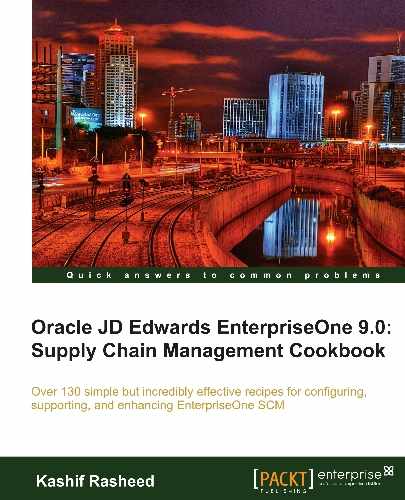The system applies a discount factor to the unit price in order to determine the net price. The system retrieves this value from the inventory pricing rules, if you have assigned a rule to this item. The pricing rule set-up determines whether the system multiplies the unit price by this value or adds it to or deducts it from the unit price.
Define the Item Price Group in the Inventory management system in order to set up the discount terms.
- Access the Inventory Pricing Rules application from the G43A17 menu, and then click on Inventory Price Rule.

- Enter a value in the Pricing Rule field, taken from the Item Price Groups (40/PI) UDC that the system uses to classify inventory by pricing rules.
- Enter P for purchase order discounts in the Price Method field from the (42/CT) UDC that indicates the basis for the price rule. P for purchase order discounts.
- Enter a value in the Contract Pricing field, taken from the Pricing Type (42/PT) UDC, to specify a special pricing relationship between the item and one or more of the customers. The inventory pricing rule code for a contract is the item number.
- Enter an alphanumeric code in the Level field that determines the sequence in which the system displays the rules within the pricing group. You define levels when you set up the pricing groups. You must enter a value in the Level field for each discount that is applicable to the rule.
- Enter an Up To Quantity value for the volume or quantity breaks commonly used in pricing tables. For example, if the quantity on the first level of a rule is 5, then the pricing logic on this level applies only to sales of five or fewer items. If the quantity on the next level is 10, then the pricing logic applies to sales of six through ten items. 99,999,999 indicates all quantities.
- Enter a value in the Basis field from the Cost/Price Basis (H42/CB) UDC. The system uses the value that you enter to determine the order's net price.
- In sales order repricing, the system bases all reprice calculations on either the unit cost or the price in the sales detail. Specify P if you want the system to use the unit price in the sales order as the basis for reprice calculations. Otherwise, specify a value between 1 and 8 to use the unit cost in the sales detail as the base on value for all reprice calculations.
- Enter a Factor Value for the discount that the system uses when it calculates the price of an item attached to this inventory pricing rule. Discounts can be expressed as multipliers, additional amounts, or deductible amounts. For example, a 10 percent discount would be expressed as .90. You can use the same factor for markups over cost. For example, a 10 percent markup would be expressed as 1.10.
- Enter a Type value from the FVTY (H00/FV) UDC that indicates whether the factor value is a multiplier (percentage) or an additional/deductible cash amount (USD) when applied to an order's price.
- Enter an Override Price that overrides all other rules or prices.
You entered discount terms on a detail line to have the system calculate a discount on the items that you purchase. For example, a supplier might offer a 10 percent discount on certain items. When you enter a specific discount factor for a detail line, the system enters a cost for the item on the detail line based on the discount factor. For example, to specify a 10 percent discount for an item, you enter a discount factor of 0.90. If the unit cost for the item is usually 10.00, the system enters a unit cost of 9.00. You can also specify a discount for an item based on a price rule. The system applies a discount to the unit cost of the item based on the discount that has been set up for the price rule. The system retrieves a default price rule for an item for which you have attached a price rule to the branch/plant level information for the item, or for which you have attached the price rule to the supplier from whom you are pur chasing the item (or to the price group for the supplier).
You can set up as many detail categories as you need. A single code can be used for sales, purchasing, order/basket, and contract pricing. If you set up a contract rule, it must equal the short number for the item under contract. If you indicate that a pricing type is a contract, you must enter the quantity that may be sold at this contract price, and the contract number if there is one. You must also attach the contract pricing rule to the customer or customer group for the rule to become effective.
